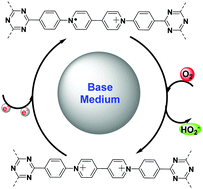Highly effective electrosynthesis of hydrogen peroxide from oxygen on a redox-active cationic covalent triazine network†
Abstract
Direct electrosynthesis of hydrogen peroxide (H2O2) by oxygen reduction is a green and safe strategy to replace the traditional anthraquinone process. Herein, we have designed a two-dimensional redox-active cationic covalent triazine network to be used directly as a cost-effective metal-free electrocatalyst for the oxygen reduction reaction (ORR) to form H2O2. Such a dicationic 2D polymer possesses a porous structure with pore diameters of 2–10 nm and a total N content of 13.3 wt%. The electron paramagnetic resonance experiment confirms the reduction of a viologen-based polymer to radical cations and the subsequent generation of superoxygen radicals. The radical characteristics and high N content within this polymer are the essential for the efficient ORR via a two-electron pathway. As a result, the present electrocatalyst exhibits a high ORR activity and excellent H2O2 selectivity (∼85%), thus providing a feasible possibility of designing highly selective metal-free electrocatalysts for electrocatalytic production of H2O2 from O2.



 Please wait while we load your content...
Please wait while we load your content...